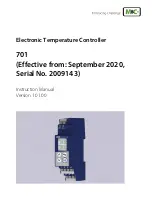
3-1
Section 3 Operation
Models SLA5810 and SLA5820
Installation and Operation Manual
X-PR-SLA5800-PC-eng
Part Number: 541B091AAG
July, 2010
3-1 Overview
This section contains the following information:
• Theory of Operation
• Features
3-2 Theory of Operation for Pressure Control
The pressure to be measured acts on a stainless steel diaphragm. Via
silicone oil, this pressure is transmitted to the actual sensing element, a
silicon chip (refer to Figure 1-1). The chip consists of an anisotropically
etched diaphragm with four piezo resistive resistors, configured in a
Wheatstone bridge, etched into its surface (refer to Figure 1-2). The
mechanical deformation of this diaphragm results in an imbalance of the
resistors which is proportional to pressure. An amplifier provides output to
the control circuit as well as the electrical output signal.
In addition to the pressure transducer the Models SLA5810 and SLA5820
have an integral control valve and control circuitry. A difference between
the pressure and setpoint signals will cause the electronics to modulate
the control valve to maintain the desired pressure. A system block diagram
is shown in Figure 3-3.
The integration of pressure transducer, control electronics and control
valve into one unit results in a compact size. The mounting dimensions are
comparable to a mass flow controller. Refer to Figures 1-1 to 1-4.
The “upstream pressure regulation mode” shown in Figure 1-5 places the
pressure controller at the outlet of the pressure vessel. The pressure in the
process upstream of the controller will be constant independent of
downstream variation. Pressure measurement and control takes place at
the outlet side of the pressure vessel.
3-3 Features
Note: All digital pressure controllers are configured at the factory according to
customer order and do not require adjustment. Not all features are available
on all instruments.
The SLA5810 and SLA5820 are a full-featured digital PCs. The Digital PC
performs much like a traditional analog PC, but with improved accuracy, step
response and valve control. The analog interface matches that of Brooks'
popular analog PCs so it can be retrofitted into tools using analog PCs. Other
versions of the Digital PC can provide a variety of digital protocols, for
example DeviceNet.
















































